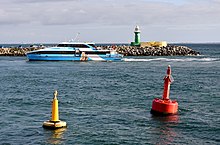AIS AtoNs
AtoNs can be integrated with automatic identification system (AIS). AIS transmitted form an actual aid (buoy, lighthouse etc.) is termed a "real AIS AtoN". [11]
If it is impractical to equip the AtoN with an AIS transponder an AIS shore station can be assigned to transmit AIS messages on behalf of the AtoN. This is known as a "synthetic ATON". Synthetic AtoNs can be either "monitored synthetic AtoNs" or "predicted synthetic AtoNs". The former have a link between the AtoN so that the AIS station can confirm the AtoNs status. The latter have no link and the AIS system just predicts that the AtoN is where it should be.
If there is no real AtoN (such as for the short term marking of a wreck) then a "virtual AIS AtoN" is used.
Each AIS AtoN must have a unique Maritime Mobile Service Identity (MMSI) number. Synthetic and virtual AIS AtoNs mark their messages as repeats to indicate that the location of the transmitter is not the location of the AtoN.
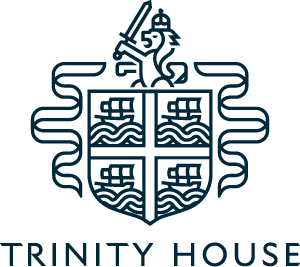
The Corporation of Trinity House of Deptford Strond, also known as Trinity House, is the official authority for lighthouses in England, Wales, the Channel Islands and Gibraltar. Trinity House is also responsible for the provision and maintenance of other navigational aids, such as lightvessels, buoys, and maritime radio/satellite communication systems. It is also an official deep sea pilotage authority, providing expert navigators for ships trading in Northern European waters.

A buoy is a floating device that can have many purposes. It can be anchored (stationary) or allowed to drift with ocean currents.
The International Association of Marine Aids to Navigation and Lighthouse Authorities (IALA), previously known as International Association of Lighthouse Authorities, is an intergovernmental organization founded in 1957 to collect and provide nautical expertise and advice. IALA is also known by its French name of Association Internationale de Signalisation Maritime (AISM).

A lateral buoy, lateral post or lateral mark, as defined by the International Association of Marine Aids to Navigation and Lighthouse Authorities, is a sea mark used in maritime pilotage to indicate the edge of a channel.
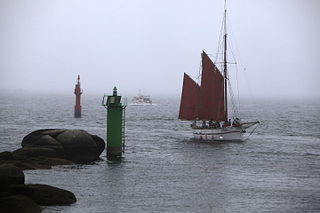
A sea mark, also seamark and navigation mark, is a form of aid to navigation and pilotage that identifies the approximate position of a maritime channel, hazard, or administrative area to allow boats, ships, and seaplanes to navigate safely.

A sector light is a man-made pilotage and position fixing aid that consists of strictly delineated horizontal angle light beams to guide water-borne traffic through a safe channel at night in reasonable visibility. Sector lights are most often used for safe passage through shallow or dangerous waters. This may be when leaving or entering harbour. Nautical charts give all the required information.
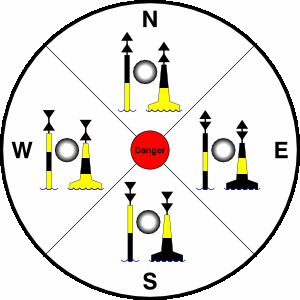
A cardinal mark is a sea mark used in maritime pilotage to indicate the position of a hazard and the direction of safe water.
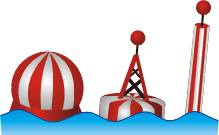
A safe water mark, as defined by the International Association of Lighthouse Authorities, is a sea mark used in maritime pilotage to indicate the end of a channel. They usually imply that open, deep and safe water lies ahead. They are also used to indicate the start and end of a buoyed section of a continuous narrow channel; and a series of them may mark a safe route through shallow areas. It is therefore important to consult appropriate charts to determine their meaning in each location. They are also known as fairway buoys and clear water buoys.

An Isolated Danger Mark, as defined by the International Association of Lighthouse Authorities, is a sea mark used in maritime pilotage to indicate a hazard to shipping such as a partially submerged rock.

The Thames Estuary is where the River Thames meets the waters of the North Sea, in the south-east of Great Britain.
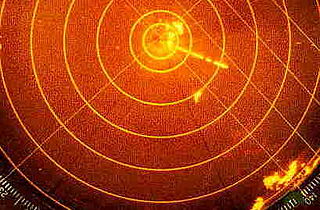
Radar beacon is – according to article 1.103 of the International Telecommunication Union's (ITU) ITU Radio Regulations (RR) – defined as "A transmitter-receiver associated with a fixed navigational mark which, when triggered by a radar, automatically returns a distinctive signal which can appear on the display of the triggering radar, providing range, bearing and identification information." Each station shall be classified by the service in which it operates permanently or temporarily.
MV Tricolor was a 50,000 tonne Norwegian-flagged vehicle carrier built in 1987, notable for having been involved in three English Channel collisions within a fortnight.

The automatic identification system (AIS) is an automatic tracking system that uses transceivers on ships and is used by vessel traffic services (VTS). When satellites are used to receive AIS signatures, the term Satellite-AIS (S-AIS) is used. AIS information supplements marine radar, which continues to be the primary method of collision avoidance for water transport. Although technically and operationally distinct, the ADS-B system is analogous to AIS and performs a similar function for aircraft.

A day beacon is an unlighted nautical sea mark. A signboard identifying it is called a day mark. Day beacons typically mark channels whose key points are marked by lighted buoys. They may also mark smaller navigable routes in their entirety. They are the most common navigation aid in shallow water, as they are relatively inexpensive to install and maintain. Navigation around them is similar to that around other navigation aids.
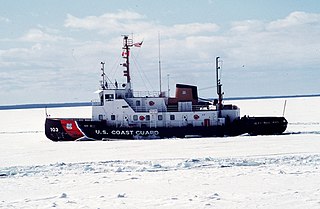
USCGC Mobile Bay (WTGB-103) is an active icebreaking tug under the direction of the United States Coast Guard. Her homeport is located in Sturgeon Bay, Wisconsin. She is one of two ships in her class that has been equipped with a 120-foot (37 m) aids-to-navigation (ATON) barge operating on the Great Lakes. The vessel was specifically designed to carry out icebreaking missions, but also carries out missions in Search and Rescue, Environmental Pollution Response, Maritime Law Enforcement and Homeland Security.

USCGC Woodrush (WLB-407) was a buoy tender that performed general aids-to-navigation (ATON), search and rescue (SAR), and icebreaking duties for the United States Coast Guard (USCG) from 1944 to 2001 from home ports of Duluth, Minnesota and Sitka, Alaska. She responded from Duluth at full speed through a gale and high seas to the scene of the SS Edmund Fitzgerald sinking in 1975. In 1980, she took part in a rescue rated in the top 10 USCG rescues when she helped to save the passengers and crew of the cruise ship Prinsendam after it caught fire in position 57°38"N 140° 25"W then while being towed sank off Graham Island, British Columbia. She was one of the first vessels to respond to the Exxon Valdez oil spill in 1989. She was decommissioned on 2 March 2001 and sold to the Republic of Ghana to serve in the Ghana Navy.
Enhanced radar positioning is a proposal for a position fixing system in maritime navigation, based on radar navigation. It is the automation of the process of determining own position by means of radar fixing, using a multitude of objects with known position as reference.

The North Bull Lighthouse, is an active aid to navigation located at the mouth of the River Liffey, near Dublin, Ireland. It is one of four lighthouses that help guide shipping into the Liffey, and the Port of Dublin, all of which are operated and maintained by the Dublin Port Company.

The USCGC Walnut (WLM-252) was a steel-hulled, steam-powered twin-screw Hollyhock-class tender built for the Lighthouse Service in 1939 at Oakland, California. With the transfer of the Lighthouse Service to the Coast Guard in June, 1939, she was commissioned as a Coast Guard cutter on 8 July 1939.

An Emergency wreck buoy is used to warn of a new wreck which has not yet been listed in maritime documents. The buoy is expected to be deployed for the first 24-72 hours after the wreck occurs. After that time more permanent buoyage should be deployed and charts updated.
